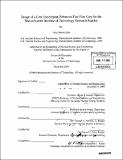Design of a low enrichment, enhanced fast flux core for the Massachusetts Institute of Technology Research Reactor
Author(s)
Ellis, Tyler Shawn
DownloadFull printable version (40.62Mb)
Other Contributors
Massachusetts Institute of Technology. Dept. of Nuclear Science and Engineering.
Advisor
Mujid S. Kazimi and Benoit Forget.
Terms of use
Metadata
Show full item recordAbstract
Worldwide, there is limited test reactor capacity to perform the required irradiation experiments on advanced fast reactor materials and fuel designs. This is particularly true in the U.S., which no longer has an operating fast reactor but depends upon two aging thermal reactors for testing the behavior of various materials in an irradiation environment. The MIT research reactor is planning for a new core to end the need for highly enriched uranium and operate the reactor with uranium enrichments under 20%. This study explores the use of the central region in the newly proposed MIT reactor core to boost the production of fast neutrons, thus making the new core more beneficial for materials testing. The Fast Flux Trap introduces a region of fissile material surrounding a central irradiation facility which is cooled by liquid lead-bismuth eutectic. This arrangement maximizes the fast neutron production by avoiding neutron moderation in the center. The fissile material, arranged in a tight hexagonal pin array, can be uranium enriched in either 235U or 233U, to the limit allowable for non-proliferation. Insertion of the Fast Flux Trap in the proposed low enriched uranium core operated at a 10 MW power level, can provide a 252%-271% higher fast neutron flux than the previously proposed designs with low enriched fuel for the MIT research reactor and a 235%-253% higher fast neutron flux than the existing highly enriched uranium MITR-II core at 5 MW. (cont.) This new core fast flux capability is within a factor of 2 to 4 of the much larger national test reactors, the Advanced Test Reactor and the High Flux Isotope Reactor, and hence can allow the MIT research reactor to be more useful for fast irradiation. The work covered both steady state and transient events involving the Fast Flux Trap, using the Monte Carlo N-Particle (MCNP) transport code. It was shown that the power distribution within the Fast Flux Trap pins as well as the plates in the rest of the core will be satisfactory; or in other words, no excessive power peaking will develop. The limits of the Fast Flux Trap lifetime were found to exceed the expected licensing time of the new core. Furthermore, the reactivity implications of metallic coolant leaks, water flooding of the Fast Flux Trap and various possible test materials were all found to be acceptable. The loss of flow following a pump trip event was analyzed using the RELAP5-3D code, and found not to result in excessive temperatures with regards to materials strength and corrosion resistance. While the specific design developed in this dissertation is particular to the MIT research reactor core, the Fast Flux Trap design concept can potentially be applied in other reactor cores so that other thermal spectrum research and test reactor facilities can benefit from this enhanced capability.
Description
Thesis (Ph. D.)--Massachusetts Institute of Technology, Dept. of Nuclear Science and Engineering, February 2009. Cataloged from PDF version of thesis. Includes bibliographical references (p. 115-117).
Date issued
2009Department
Massachusetts Institute of Technology. Department of Nuclear Science and EngineeringPublisher
Massachusetts Institute of Technology
Keywords
Nuclear Science and Engineering.